Text

14. Nicobar Scrubfowl
11 notes
·
View notes
Text
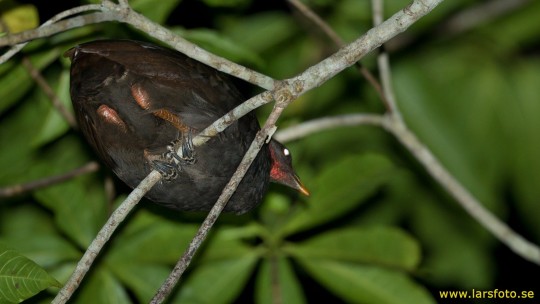
[769/10,977] Biak Scrubfowl - Megapodius geelvinkianus
Also known as: Biak Megapode
Order: Galliformes Family: Megapodiidae (megapodes)
Photo credit: Lars Petersson via Macaulay Library
13 notes
·
View notes
Text

the orange footed scrubfowl
3 notes
·
View notes
Text
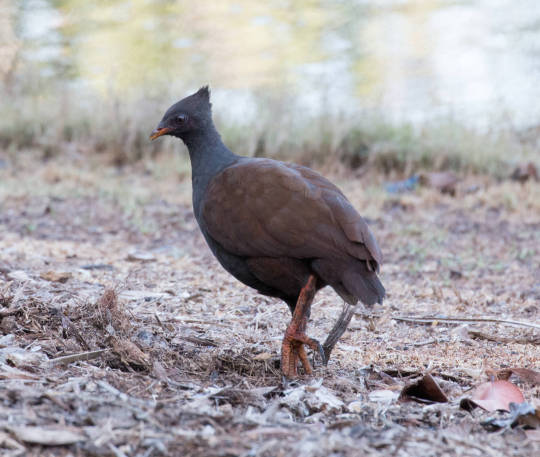
Orange-footed scrubfowl (Megapodius reinwardt) by Hix
2 notes
·
View notes
Text
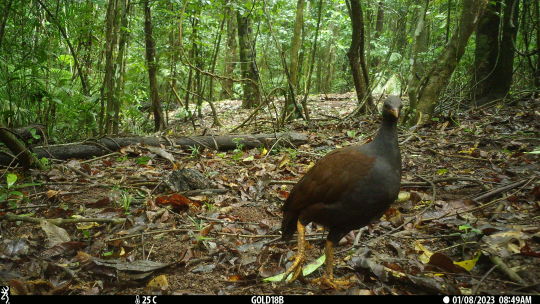
#i haven't posted one of these in ages#i still have so many to share#anyways i see so many of these guys but they are always very cute and funny#camera trap#orange-footed scrubfowl#creature#also i know their scientific name off by heart now:#megapodius reinwardt
1 note
·
View note
Text
Birds of Maglor’s Gap and Lothlann
This completes my series on birds of the Fëanorian realms pre Amon Ereb!!
March of Maedhros, Himlad, Thargelion, Estolad
Flora, Fauna, geography and environment of Arda Masterlist
Maglor’s Gap was the widest break in the mountains and cliffs dividing Beleriand and the lands to the north. It lay between the blue mountains to the east and the March of Maedhros to the west. Lothlann was a wide expanse of plains to the north of the Gap. The rivers greater and little Gelion ran around the western and eastern borders.
Steppes and plains: Daurian, see see partridge, yellowhammer, black grouse, grey necked bunting, great rosefinch, imperial Eagle, steppe eagle, golden eagle, Mongolian ground jay (rare), greater short toed lark, upland buzzard, Pallas’s sandgrouse, laughing dove, great bustard, bush quail, gray, black and painted francolin, snowcock, little bustard, merlin, cheer pheasant, crested lark, painted sandgrouse, scrubfowl, common quail, brown accentor, ring necked pheasant, grey partridge, black bellied sandgrouse, common buzzard, black kite
By greater and little Gelion (stream/river): black faced bunting, Pallas’s bunting, pin tailed sandgrouse (summer only), white throated dipper, brown dipper, common kingfisher, hobby, swamphen
World building notes
--Laughing doves appear on the sigil of some of Maglor’s host who are particularly skilled in the use of song in battle
-Many of Maglor’s cavalry hunt or fight with birds including golden, steppe and imperial eagles.
-Game birds of the prairie steppes such as partridge make up much of the meat that the cavalry and scouts eat, along with hares.
-Most of the cavalry have horse hair plumes but some of the lieutenants and generals have feathers from pheasants or eagles.
-Emu are actually domesticated in some parts of the world and I love the idea of them being kept in both the Gap and Himlad as well as by peoples East of the Ered Luin. They have a huge variety of uses including leather, oil, eggs and meat. And the chicks are very cute 💙
-I am a huge proponent of prehistoric and extinct animals living throughout Arda, as per Tolkien’s comments about “all creatures which walk or have walked the earth”. I really like the idea of small brush moas living near the mountain borders of the Gap
27 notes
·
View notes
Text

omg. this is 1000000% not in sequence. and i do try to always stick to the same session of play.
BUT OMFG I DL REALISTIC SWIMMING AND ONE OF THEM DROWNED!!!!!!!!!!!!!!!!!!
i quit w/o saving. i dl-ed the mod and didn't read anything about it!!! it was traumatising. but also cool how she just floats down and away.
swimming lessons all around are required!!
also i broke another 100 babies rule bc this is how i get to 100. freebuild mode and using it to delete the house i dl-ed when i failed at creating my own in sulani. i don't remember who made it....but thank you, it served me well
deleting the house gave me loads of much needed money. i need to take a bunch away before it gets boring that she doesn't need anything bc she is so rich.
so i spent literally days finding a new house. everyone went to the sulani bar so we could get some sim sperm.
BUT WHILE I WAS FLIRTING MY CHILD DIED!?!?!
no. i cannot accept that!! and she only died bc i put a mod in and didn't see how it worked prior. idc if she did die. it was a fluke based on my lack of research.
it also took me hours and hours to get the inside to my liking. i find the layout confusing!
i made a weird cement catwalk thingy and continued using free build mode to get hydroponic planters so they need less attention. i don't actually know if it will work. idk what to do w/all my plants when the lot and the house size are the same. i need at least 20 planters!!! i cannot create the space w/o scrubfowl a big part of the design?
how do you do it?
#simblr#sims4#sims 4#the sims4#thesims4#the sims#ts4#the sims 4#sims#thesims#simmer#my sims#show us your sims#sims 4 aesthetic#sims 4 cc#sims 4 community#sims 4 custom content#sims 4 gameplay#sims 4 maxis match#sims 4 simblr#sims 4 stories#sims 4 story#sims aesthetic#sims gameplay#sims community#zemfer#audrina zemfer#100 baby challenge#theozma#the ozma
3 notes
·
View notes
Text




221) Megapodius reinwardt; nogal zmienny, orange-footed scrubfowl (kurak pomarańczowonogi), orange-footed megapode - niewielki megapod z rodziny Megapodiidae występujący na wielu wyspach Małych Wysp Sundajskich, a także w południowej Nowej Gwinei i północnej Australii.
Jest to ptak lądowy wielkości kury domowej, o ciemnym kolorze, z mocnymi pomarańczowymi nogami i spiczastym grzebieniem z tyłu głowy. Wykorzystuje szereg siedlisk le��nych i zaroślowych i skolonizował wiele małych wysp w całym swoim zasięgu. Jest płodny w podmiejskich ogrodach Darwin, gdzie ludzie nazywają go bush chook (kurą buszową), bush chicken (kurczakiem buszowym) lub bush turkey (indykiem buszowym).
Ogólnie rzecz biorąc, populacje wydają się być stabilne, a status ochrony gatunku jest uważany za najmniejszy. Kurak pomarańczowonogi żywi się nasionami, opadłymi owocami i bezkręgowcami lądowymi.
Istnieje 5 podgatunków. Niektóre podgatunki mogą być traktowane jako pełne gatunki, takie jak kurak tanimbarski (Megapodius tenimberensis), podczas gdy inne podgatunki mogą być uważane za podgatunki innych gatunków (np. M. r. buruensis jest czasami uważany za podgatunek dusky megapode):
M. r. buruensis
M. r. castanonotus
M. r. reinwardt
M. r. macgillivrayi
M. r. tumulus
M. r. yorki.
Ludzie z plemienia Kunwinjku z zachodniej części Ziemi Arnhemskiej znają tego ptaka jako kurrukurldanj.
0 notes
Text
the scrubfowl are NOISY tonight
0 notes
Photo
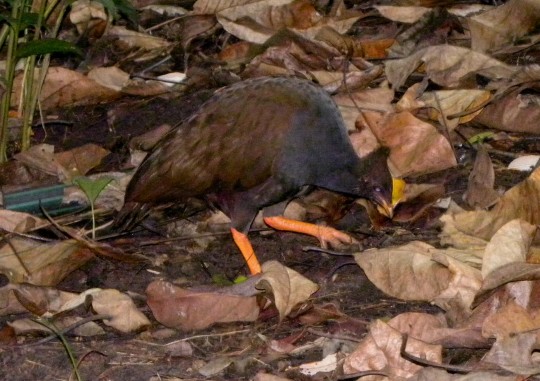
Orange-footed scrubfowl (Megapodius reinwardt)
Photo by Charles Cuthbert
#orange footed scrubfowl#scrubfowl#megapodius reinwardt#megapodius#megapodiidae#galliformes#galloanserae#neognathae#aves#theropoda#archosauria#sauropsida#reptilia#tetrapoda#vertebrata#chordata
13 notes
·
View notes
Text
Megapodius

Orange-Footed Scrubfowl, M. reinwardt, by Bernard Dupont, CC BY-SA 2.0
PLEASE SUPPORT US ON PATREON. EACH and EVERY DONATION helps to keep this blog running! Any amount, even ONE DOLLAR is APPRECIATED! IF YOU ENJOY THIS CONTENT, please CONSIDER DONATING!
Name: Megapodius
Status: Extant
First Described: 1823
Described By: Gaimard
Classification: Dinosauria, Saurischia, Eusaurischia, Theropoda, Neotheropoda, Averostra, Tetanurae, Orionides, Avetheropoda, Coelurosauria, Tyrannoraptora, Maniraptoriformes, Maniraptora, Pennaraptora, Paraves, Eumaniraptora, Averaptora, Avialae, Euavialae, Avebrevicauda, Pygostylia, Ornithothoraces, Euornithes, Ornithuromorpha, Ornithurae, Neornithes, Neognathae, Galloanserae, Pangalliformes, Galliformes, Megapodiidae
Referred Species: M. pritchardii (Tongan Megapode, Extant), M. laperouse (Micronesian Megapode, Extant), M. nicobariensis (Nicobar Megapode, Extant), M. cumingii (Philippine Megapode, Extant), M. bernsteinii (Sula Megapode, Extant), M. tenimberensis (Tanimbar Megapode, Extant), M. freycinet (Dusky Megapode, Extant), M. geelvinkianus (Biak Scrubfowl, Extant), M. eremita (Melanesian Megapode, Extant), M. layardi (Vanuatu Megapode, Extant), M. affinis (New Guinea Scrubfowl, Extant), M. reinwardt (Orange-Footed Scrubfowl, Extant), M. molistructor (Pile-Builder Scrubfowl, Extinct), M. amissus (Viti Levu Scrubfowl, Extinct)

Micronesian Megapode, M. laperouse, by Michael Lusk, CC BY-SA 2.0
Megapodius is, by far, the largest genus of Megapodes, with many species making up its genus. Most of these species are alive today, though there are two distinct extinct ones as well. These birds are commonly called Scrubfowl, and, like all Megapodes, are distinctly unique due to their highly specialized method of egg incubation. M. molistructor, the Pile-Builder Megapode, is an extinct species from New Caledonia and Tonga, known from only about 12,000 years ago on, in the Holocene of the Quaternary. Weighing about 3.5 kilograms, it was the heaviest species in this genus, and one of the largest ground-dwelling birds of the islands it lived on. This bird probably went extinct due to the arrival of human settlers about 3500 years ago. The other extinct Speices, M. amissus, the Viti Levu Scrubfowl, was a Megapode known from Fiji during the Holocene, about the size of the Orange-Footed Scrubfowl, though with more robust legs and reduced wings, indicating flightlessness. It, too, went extinct due to overhunting and other human activity.
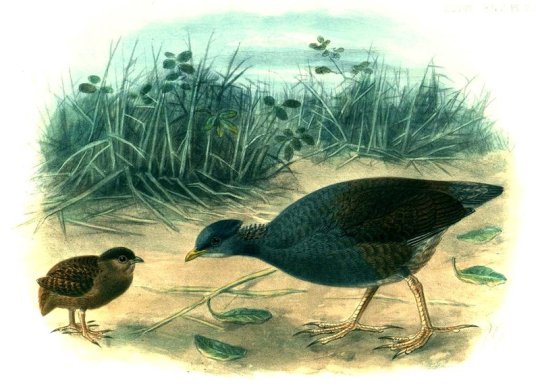
Tongan Megapode, M. pritchardii, by Walter Lawry Buller, in the Public Domain
The Tongan Megapode is an endangered species known from Tonga, the only remaining species of Megapode still known from these islands, even though multiple species were present prior to the arrival of humans. Their remote habitat made populations of these birds vulnerable to human activity. They live primarily in tropical lowland forests, and they use the warm volcanic soil of their habitats to incubate their eggs. The baby birds are able to fly immediately upon hatching. These birds are threatened due to human hunting and habitat reduction.
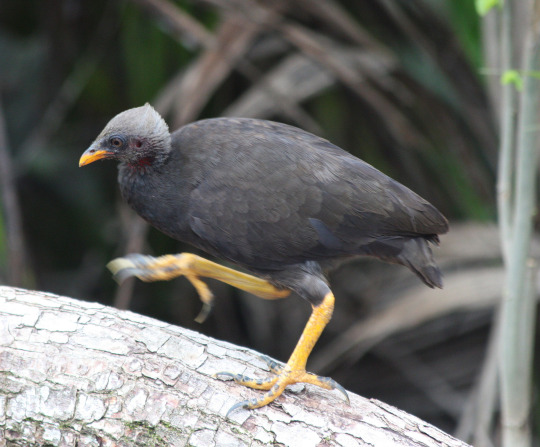
Micronesian Megapode, M. laperouse, by Michael Lusk, CC BY-SA 2.0
The Micronesian Megapode is another endangered species, about 38 centimeters in length, from the Marianas Islands. Medium-sized birds, they have pale heads, dark bodies, and bright yellow legs. They are usually found in thickets and lowland scrub, and they’re very shy and secretive. They breed after the monsoon season and make large mounds of debris to lay their eggs, sometimes multiple females using the same mound. They are protected, but the introduction of mammalian predators have greatly reduced their populations.
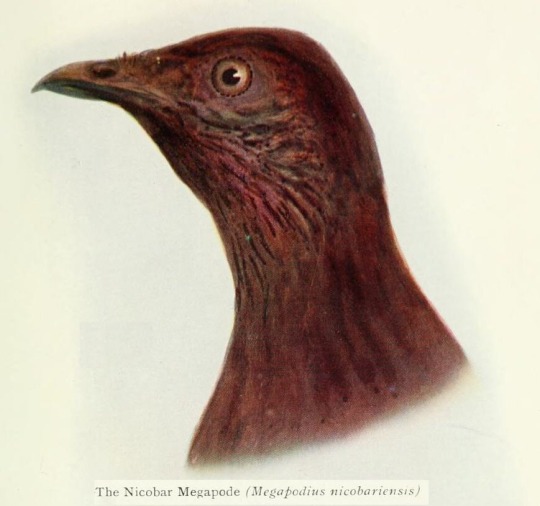
Nicobar Megapode, M. nicobariensis, by R. W. Shufeldt, in the Public Domain
The Nicobar Megapode is a vulnerable species known from the Nicobar Islands of India. It builds large nest mounds, like the other species in this genus; but are very secretive in how they do so - they primarily build mounds near the coast with coral sand and plant material, and the mounds are often reused. The young birds are fully feathered, and can fly as soon as their feathers dry up. They mainly move around in thick jungle during the day, and go out onto the shore of the ocean at night, mainly walking in small groups or pairs. They eat both plant and animal material, ingesting grit to aid in digestion. They are brownish birds, and are primarily threatened due to habitat loss and human activity.
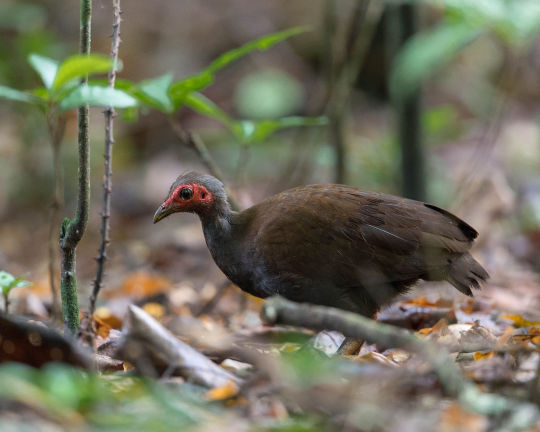
Philippine Megapode, M. cumingii, by Jason Thompson, CC BY 2.0
The Philippine Megapode, which is such a little cutie, is a non-threatened species found in the Philippines, Borneo, and Sulawesi, mainly in dry forest, moist lowland forest, and mountain forests.
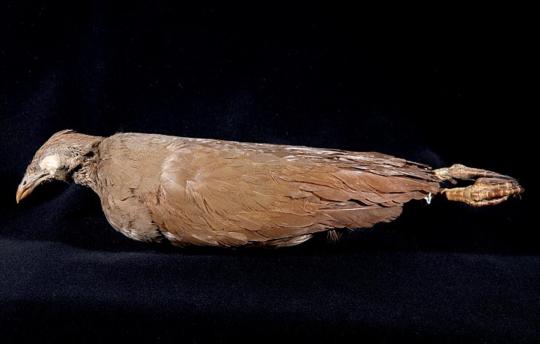
Sula Megapode, M. bernsteinii, by Huub Veldhuijzen van Zanten, CC BY-SA 3.0
The Sula Megapode, is a vulnerable species known on the Banggai and Sula Islands in Indonesia, primarily in tropical and subtropical forest, both dry and wet, as well as mangrove forests. As such, it is extensively threatened with habitat destruction. These birds are reddish brown, with short pointed crests, and they grow up to 35 centimeters in length. They forage in pairs, or sometimes small groups, mainly on roots and invertebrates. They perform mating dances, to an extent, where all the birds call out together, and then build cone-shape mounds over rotting vegetation to keep the eggs warm. The Tanimbar Megapode, M. tenimberensis, on the other hand, is a near-threatened species from the Tanimbar Islands of Indonesia, about the size of a domestic chicken. It’s primarily found in forest and scrubland, and feeds on fallen fruit, seeds, and invertebrates.

Dusky Megapode, M. freycinet, by Nicolas Huet, in the Public Domain
The Dusky Megapode, is a 41 centimeters long black bird with a short pointed crest and red facial skin. They look similar across the sexes, and build mounds made of leaves, sand, gravel, and sticks, as large as 11 meters in diameter. They are very common birds and not considered currently threatened with extinction.
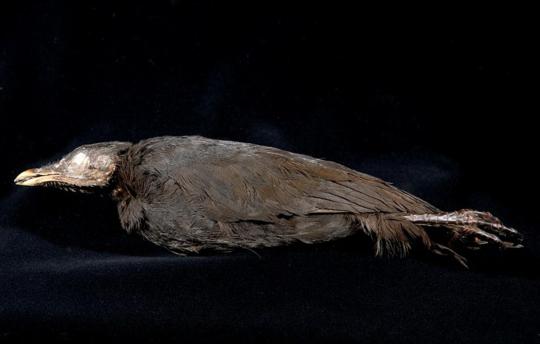
Biak Scrubfowl, M. geelvinkianus, by Huub Veldhuijzen van Zanten, CC BY-SA 3.0
The Biak Scrubfowl is a vulnerable species known from islands in West Papua, Indonesia, measuring about 36 centimeters in length, with dark grey feathers and a blueish face. They live in lowland tropical forests and some shrublands, which has lead to its threatened position due to habitat loss.
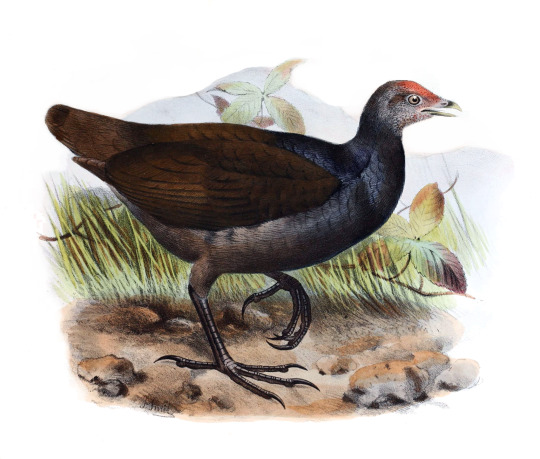
Melanesian Megapode, M. eremita, by Joseph Smit, in the Public Domain
The Melanesian Megapode is a nonthreatened scrubfowl species from Papua New Guinea and the Solomon Islands, living in tropical lowland forests and some mountain forests. It has brown and blue feathers, and a red patch on its head.

Vanuatu Megapode, M. layardi, by W. R. Ogilvie-Grant, in the Public Domain
The Vanuatu Megapode is a vulnerable species known from the island of Vanuatu, living in subtropical and tropical lowland forest. Unfortunately, it’s threatened by habitat loss and egg hunting. The New Guinea Scrubfowl, N. decollatus, on the other hands, is a poorly studied nonthreatened Megapode from tropical lowland forests and mountain forests in New Guinea, but unfortunately it isn’t very well documented.
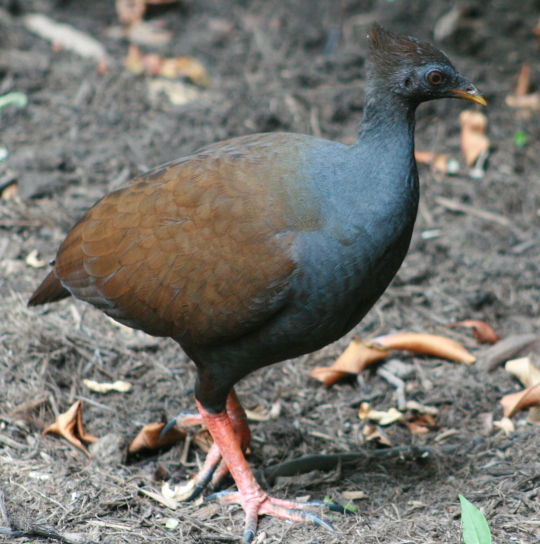
Orange-Footed Scrubfowl, M. reinwardt, by Toby Hudson, CC BY-SA 3.0
Finally, the Orange-Footed Scrubfowl is a non-threatened species from the Sunda Islands, New Guinea, and Australia. The size of a chicken, it has brown and blue feathers, with orange feet, hence its name. They also have distinctive pointy crests. They live in forest and scrubland habitat, and make mounds of sand and leaf litter that can reach up to 4.5 meters in height. They mainly eat seeds, fallen fruit, and some invertebrates.
Buy the author a coffee: http://ko-fi.com/kulindadromeus
Sources:
https://en.wikipedia.org/wiki/Scrubfowl
https://en.wikipedia.org/wiki/Pile-builder_megapode
https://en.wikipedia.org/wiki/Viti_Levu_scrubfowl
https://en.wikipedia.org/wiki/Tongan_megapode
https://en.wikipedia.org/wiki/Micronesian_megapode
https://en.wikipedia.org/wiki/Nicobar_megapode
https://en.wikipedia.org/wiki/Philippine_megapode
https://en.wikipedia.org/wiki/Sula_megapode
https://en.wikipedia.org/wiki/Tanimbar_megapode
https://en.wikipedia.org/wiki/Dusky_megapode
https://en.wikipedia.org/wiki/Biak_scrubfowl
https://en.wikipedia.org/wiki/Melanesian_megapode
https://en.wikipedia.org/wiki/Vanuatu_megapode
https://en.wikipedia.org/wiki/New_Guinea_scrubfowl
https://en.wikipedia.org/wiki/Orange-footed_scrubfowl
#megapodius#scrubfowl#megapode#dinosaur#chicken#pheasant#birblr#palaeoblr#megapodius pritchardii#tongan megapode#megapodius laperouse#micronesian megapode#megapodius nicobariensis#nicobar megapode#megapodius cumingii#philippine megapode#megapodius bernsteinii#sula megapode#megapodius tenimberensis#tanimbar megapode#megapodius freycinet#dusky megapode#megapodius geelvinkianus#biak scrubfowl#megapodius eremita#melanesian megapode#megapodius layardi#vanuatu megapode#megapodius affinis#new guinea scrubfowl
45 notes
·
View notes
Photo


Finished pages from the Art of the 6th Extinction book (companion to the 6th Extinction card deck). I’ll be doing a general announcement when the deck & book are ready; both are currently at the printers. Text written by myself, book layout me and Catspaw Productions.
29 notes
·
View notes
Photo

Orange-footed scrubfowl. 🔎 (Megapodius reinwardt). ⏳ Conservation Status: Least Concern. Population stable. 🗺 Endemicity: Australia, Indonesia, Papua New Guinea, Timor-Leste. 📷 Wonga Beach, Queensland. – – #orangefootedscrubfowl #scrubfowl #birdsofaustralia #australia #queensland #wettropics #birdsofinstagram #naturephotography #birdsofthetropics #birds #birdphotography #thewettropics #nature #photography #birdwatching (at Wonga Beach) https://www.instagram.com/p/Boy0BQXhXuk/?utm_source=ig_tumblr_share&igshid=1b18n7p14gp8z
#orangefootedscrubfowl#scrubfowl#birdsofaustralia#australia#queensland#wettropics#birdsofinstagram#naturephotography#birdsofthetropics#birds#birdphotography#thewettropics#nature#photography#birdwatching
1 note
·
View note
Photo

November 13, 2017 - Orange-footed Scrubfowl or Orange-footed Megapode (Megapodius reinwardt)
These megapodes are found in parts of Indonesia, New Guinea, and northern Australia. They eat mostly plant foods, including seeds, berries, roots, fruits, shoots, and flowers, along with some invertebrates and small vertebrates. Breeding during and after rains, they build large nest mounds, using the heat produced by decaying plant material to incubate their eggs. The chicks dig themselves out of the mounds after hatching and are developed enough to run immediately and fly very short distances soon after.
#orange-footed scrubfowl#scrubfowl#megapode#megapodius reinwardt#bird#birds#illustration#art#tropical#birblr art
56 notes
·
View notes
Text



First sighting, Orange Footed Scrubfowl
(On my travels)
Diwan, in the Daintree National Park
#original photographers#nature photography#wildlife photography#bird photography#Orange Footed Scrubfowl#Diwan#Daintree National Park
30 notes
·
View notes
Photo

SSS 36 (Bush Turkeys)
The Australian Brush-Turkey (bottom-left), Australian Bustard (right) and the Orange-Footed Scrubfowl (top-left) are referred to as Bush Turkeys by various folks throughout Australia despite not being closely related to one another...
#SouthSummerSketches#digital drawing#beginner artist#birds#turkey#bushturkey#brushturkey#scrub turkey#bustard#plains turkey#scrubfowl#orange-footed scrubfowl#bush chook
0 notes